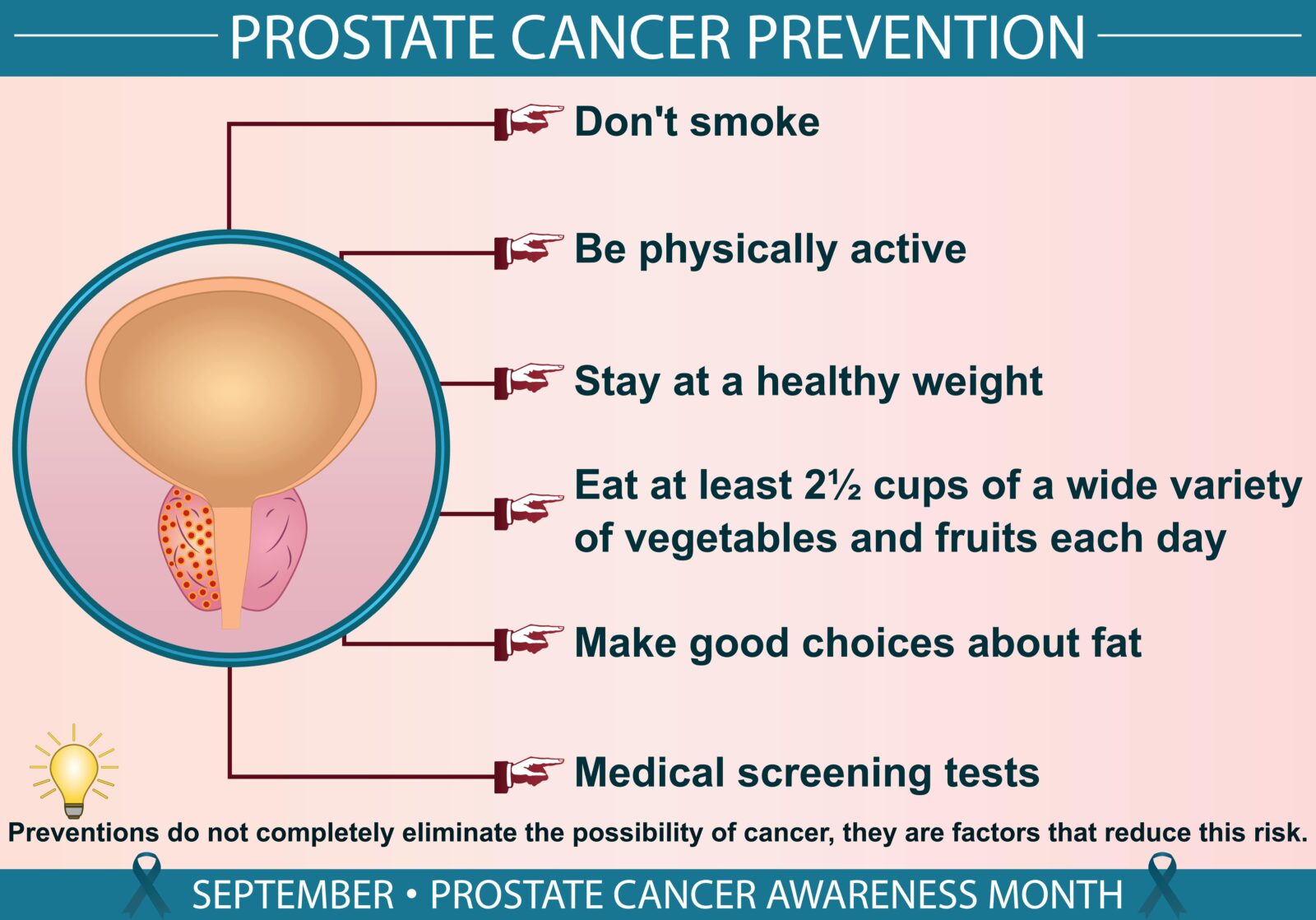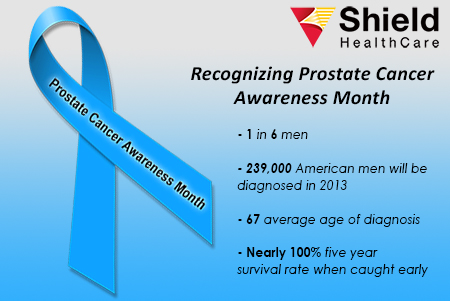
What is Prostate Cancer?
Definition and basic information about prostate cancer
Prostate cancer is a type of cancer that develops in the prostate, a small gland located below the bladder in men. It occurs when abnormal cells in the prostate gland start to grow uncontrollably. Prostate cancer is one of the most common types of cancer in men, but with early detection and treatment, it can be effectively managed. Regular screenings and awareness are crucial in detecting prostate cancer in its early stages when it is most treatable. September is recognized as Prostate Cancer Awareness Month, a time to raise awareness about this disease and encourage men to get screened regularly. By spreading awareness and understanding, we can help save lives and improve outcomes for those affected by prostate cancer.

Risk Factors for Prostate Cancer
Age, family history, race, and other factors that increase the risk of prostate cancer
Prostate Cancer Awareness Month is an important time to educate ourselves about the risk factors associated with this disease. While prostate cancer can affect any man, certain factors can increase the likelihood of developing it.
Age is one of the most significant risk factors. The chances of developing prostate cancer increase significantly after the age of 50. Family history also plays a role, as men with a close relative who has had prostate cancer are more likely to develop it themselves.
Race is another factor to consider. African American men have a higher risk of developing prostate cancer compared to men of other races. Additionally, men with a diet high in red meat and low in fruits and vegetables may have an increased risk.
Other factors that can increase the risk of prostate cancer include obesity, smoking, and exposure to certain chemicals. It’s important to note that having one or more risk factors does not guarantee that an individual will develop prostate cancer, but it does increase the likelihood.
During Prostate Cancer Awareness Month, it is crucial to spread awareness about these risk factors and encourage men to take proactive steps such as regular screenings and maintaining a healthy lifestyle. Early detection plays a crucial role in successful treatment outcomes, so it’s essential for men to be informed and proactive about their health.

Signs and Symptoms of Prostate Cancer
Common symptoms to look out for and when to seek medical attention
Prostate Cancer Awareness Month is an important time to educate yourself about the signs and symptoms of this disease. Early detection can greatly increase the chances of successful treatment.
Some common symptoms of prostate cancer include difficulty urinating, frequent urination, blood in the urine or semen, and pain or discomfort in the pelvic area. It’s important to note that these symptoms can also be caused by other conditions, so it’s essential to consult a healthcare professional for an accurate diagnosis.
If you experience any of these symptoms, it’s crucial to seek medical attention promptly. Remember, early detection is key to effective treatment. Regular check-ups and screenings can help detect prostate cancer in its early stages when it’s most treatable.
During Prostate Cancer Awareness Month, take the time to educate yourself about the risk factors, prevention strategies, and available treatments for this disease. By spreading awareness and encouraging regular screenings, we can help save lives and ensure that more men receive timely and appropriate care.
Remember, knowledge is power when it comes to your health. Stay informed, stay proactive, and don’t hesitate to reach out to your healthcare provider if you have any concerns or questions about prostate cancer.

Diagnosis and Screening for Prostate Cancer
Different methods for detecting and diagnosing prostate cancer, including PSA tests and biopsies
September is Prostate Cancer Awareness Month, a time dedicated to raising awareness about the most common cancer in men. Early detection is crucial in improving outcomes, so it’s important to understand the different methods used for diagnosing and screening prostate cancer.
One common method is the prostate-specific antigen (PSA) test, which measures the levels of PSA in the blood. Elevated PSA levels may indicate the presence of prostate cancer, but further testing is needed to confirm the diagnosis.
Another diagnostic method is a biopsy, where a small sample of prostate tissue is taken and examined under a microscope. This allows doctors to determine if cancer cells are present and assess their aggressiveness.
Other imaging tests, such as ultrasound or MRI, may also be used to visualize the prostate and identify any abnormalities.
Regular screenings are recommended for men over the age of 50, or earlier for those with a family history of prostate cancer. However, it’s important to discuss individual risk factors and screening recommendations with a healthcare professional.
By understanding the different methods available for detecting and diagnosing prostate cancer, individuals can take proactive steps towards early detection and potentially life-saving treatment. Remember, knowledge is power when it comes to your health.

Treatment Options for Prostate Cancer
Overview of treatment options, such as surgery, radiation therapy, hormone therapy, and active surveillance
When it comes to prostate cancer, there are several treatment options available. These options include surgery, radiation therapy, hormone therapy, and active surveillance.
Surgery is a common treatment for prostate cancer and involves removing the prostate gland. This can be done through open surgery or minimally invasive techniques such as laparoscopic or robotic-assisted surgery.
Radiation therapy uses high-energy rays to kill cancer cells and shrink tumors. It can be delivered externally or internally through implants.
Hormone therapy is used to block the effects of testosterone, which can stimulate the growth of prostate cancer cells. This can be done through medications or surgical removal of the testicles.
Active surveillance is an option for low-risk prostate cancer cases where the tumor is monitored closely but not immediately treated. This approach allows for regular check-ups and testing to ensure that the cancer does not progress.
It’s important to note that the best treatment option for prostate cancer depends on various factors such as the stage and aggressiveness of the cancer, as well as the patient’s overall health and preferences. A thorough discussion with a healthcare professional is essential in determining the most suitable treatment plan.

Prostate Cancer Prevention and Lifestyle Factors
Proactive steps and lifestyle changes that may reduce the risk of prostate cancer
September is Prostate Cancer Awareness Month, a time to educate and raise awareness about this common form of cancer that affects men. While there is no sure way to prevent prostate cancer, there are proactive steps and lifestyle changes that may help reduce the risk.
- Maintain a Healthy Diet: Eating a balanced diet rich in fruits, vegetables, whole grains, and lean proteins can contribute to overall health and potentially lower the risk of prostate cancer.
- Exercise Regularly: Engaging in regular physical activity, such as brisk walking, jogging, or cycling, can help maintain a healthy weight and reduce the risk of various cancers, including prostate cancer.
- Avoid Tobacco and Limit Alcohol: Smoking has been linked to an increased risk of prostate cancer, so quitting smoking is essential. Additionally, excessive alcohol consumption should be avoided or limited.
- Get Regular Check-ups: Regular screenings and check-ups with a healthcare professional are crucial for early detection and treatment of prostate cancer. Discuss with your doctor when to start screenings based on your age and family history.
- Know Your Family History: Having a close relative with prostate cancer increases the risk. It’s important to be aware of your family history and inform your healthcare provider so they can determine appropriate screening recommendations.
By taking proactive steps and making healthy lifestyle choices, men can potentially reduce their risk of developing prostate cancer. Remember, early detection plays a vital role in successful treatment outcomes.
Prostate Cancer Awareness and Education
The importance of raising awareness about prostate cancer and educating the public
Prostate Cancer Awareness Month is an annual campaign held in September to raise awareness about the most common cancer among men. It aims to educate the public about the risks, symptoms, and available treatments for prostate cancer.
Raising awareness is crucial because early detection can significantly improve outcomes. By educating men about the importance of regular screenings and encouraging them to seek medical advice, we can increase the chances of detecting prostate cancer in its early stages when it is more treatable.
Additionally, spreading awareness helps to reduce stigma and encourage open conversations about prostate health. Many men may feel uncomfortable discussing their concerns or seeking medical help due to societal norms or fear. By promoting awareness, we can create a supportive environment where men feel empowered to prioritize their health and seek appropriate care.
Education is also essential for understanding the risk factors associated with prostate cancer. Age, family history, race, and certain lifestyle factors can increase the likelihood of developing the disease. By providing accurate information, we can empower individuals to make informed decisions about their health and take necessary preventive measures.
Prostate Cancer Awareness Month serves as a reminder for everyone to prioritize their health and encourages individuals to support those affected by prostate cancer. Together, we can raise awareness, promote early detection, and improve outcomes for those battling this disease.

Support for Prostate Cancer Patients and Their Families
Resources, organizations, and support systems available for individuals dealing with prostate cancer
September is Prostate Cancer Awareness Month, a time to raise awareness about this prevalent disease and show support for those affected by it. For individuals dealing with prostate cancer, there are various resources, organizations, and support systems available to provide assistance and guidance.
- Cancer Support Organizations: Organizations like the American Cancer Society and Prostate Cancer Foundation offer a wealth of information, support groups, and resources for patients and their families. They provide educational materials, access to clinical trials, and assistance in navigating the healthcare system.
- Support Groups: Joining a support group can be incredibly beneficial for individuals coping with prostate cancer. These groups provide a safe space to share experiences, seek advice, and find emotional support from others who understand what they are going through.
- Online Communities: Online communities and forums dedicated to prostate cancer allow individuals to connect with others facing similar challenges. These platforms provide a virtual support network where people can ask questions, share stories, and find encouragement.
- Counseling Services: Professional counseling services specializing in cancer-related issues can help patients and their families navigate the emotional impact of a prostate cancer diagnosis. These services offer guidance, coping strategies, and a listening ear during difficult times.
- Financial Assistance: Some organizations provide financial assistance programs to help alleviate the financial burden often associated with prostate cancer treatment. These programs may offer grants or aid in navigating insurance coverage.
By utilizing these resources and support systems, individuals dealing with prostate cancer can find the help they need to navigate their journey and receive the support necessary for physical, emotional, and financial well-being.

Conclusion
Recap of key points, the significance of Prostate Cancer Awareness Month, and the ongoing need for research and awareness
Prostate Cancer Awareness Month is an important time to raise awareness about this prevalent disease that affects millions of men worldwide. By spreading knowledge about the risk factors, symptoms, and early detection methods, we can encourage men to prioritize their health and get regular screenings. Additionally, Prostate Cancer Awareness Month highlights the ongoing need for research to develop better treatments and ultimately find a cure. Together, we can make a difference in the fight against prostate cancer and improve the lives of those affected by this disease.

